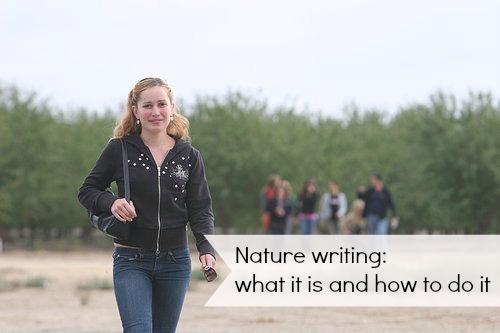Check out Part One: Introduction to Journaling if you missed it on Tuesday!
Nature Writing
This form of journaling often involves going out into nature, rather than sitting in the comfort of our homes. Although experiencing nature is essential to nature writing, it is not necessary to do all of your writing outside: even taking a few notes while you’re outside should be enough to get you started once you are back in front of a computer or at your desk.

Nature writing, or writing on the environment, can take any number of different turns: it may involve a poetical voice, a rant, a description of your surroundings, a philosophical treatise on the human-nature relationship, or a practical examination of nature, among other styles.
A big part of the style that you choose depends on your audience. Who are you writing this journal for? If it is for your own notes and thoughts, likely the form that your nature writing will take is a description of your surroundings, or philosophical musings. If it is to persuade others that as humans we have a negative impact on the earth, you may wish to include scientific facts, anecdotal evidence, and expert opinions in your writing.
The reason why most people write nature journals is to encourage people to reacquaint themselves with nature and to get in touch with their “wild” side (as opposed to the domestic). Especially with the rapidly increasing public concerns for climate change and global warming, many nature writers write to convince their readers to change their ways so that the environment can be salvaged.
Nature writing, therefore, has taken less of an emphasis on poetry, and more of an emphasis on urgently telling people how they can change to protect the environment.
Rhetorical strategies used in nature writing
The rhetorical strategies that nature writers use differs depending on the style that they choose, but most writers focus heavily on the human-nature relationship. This is because readers are more easily persuaded when they can relate to the issue at hand; hearing about environmental degradation isn’t as likely to compel us to take action unless it is discussed with how it will affect humans.
For example, “trees are dying” is easily shrugged off by most people, but “humans won’t be able to continue making XYZ equipment and will be without access to wood and fuel because vast numbers of trees are dying” is more likely to cause people to pay attention. If we put the problems into context, we will be more driven to change our ways.
Annie Dillard is particularly famous for her lyrical voice in her book, Pilgrim at Tinker Creek. She spent a year “in nature,” away from civilization, and recorded what she saw and what she thought about during her experiences.
Bill McKibben, on the other hand, makes use of analogies and scientific evidence between relaying his own stories of personal experience in his book The End of Nature. This is because his focus is on spreading awareness about climate change, whereas Dillard is more concerned with bringing people closer to nature so that we appreciate the environment. Although these two strategies are very different, they are equally effective.
Nature writing retains the most credibility when the writer has some experience of being in nature. This does not necessarily mean going to the extremes that Annie Dillard went to of escaping civilization, or the extreme that Bill McKibben has gone to of living with his wife in a cabin in the middle of the woods. Some writers will simply go out camping or on hikes to experience nature; others have lived on ranches or farms, or will live in the city but explore different aspects of nature—even parks or forests within the city—to get closer to nature.
My experience with nature writing
I wrote a nature journal as part of my Rhetoric of Nonfiction: Writing on the Environment course that I took this past semester. Our task was to find a spot in nature and write about whatever we felt like. I chose a spot in a small park about half an hour’s walk from my house, right on the river with trees all around.
I found that although I wrote a few observations about the squirrel that played nearby where I sat on a fallen log or about the shadows that danced across the ground, my usual form of writing was to consider the problem of human impact on the environment. Inevitably whenever I sat down to write, I would question our place in the world, and how the way we see ourselves and the rest of the world greatly impacts how we act.
The best way to get started with nature writing is to get outside, even just for a few minutes, and find one of these “nature spots” and jot down a few notes. What you write about can be whatever comes to mind, but it is likely that you will find you are drawn to one particular aspect about nature, the same way that I was. Nature writing can be done by anyone: the first step is to get outside, into nature, and go from there.
[…] Part Two: Nature Writing […]
[…] Part Two: Nature Writing […]
[…] Part Two: Nature Writing […]